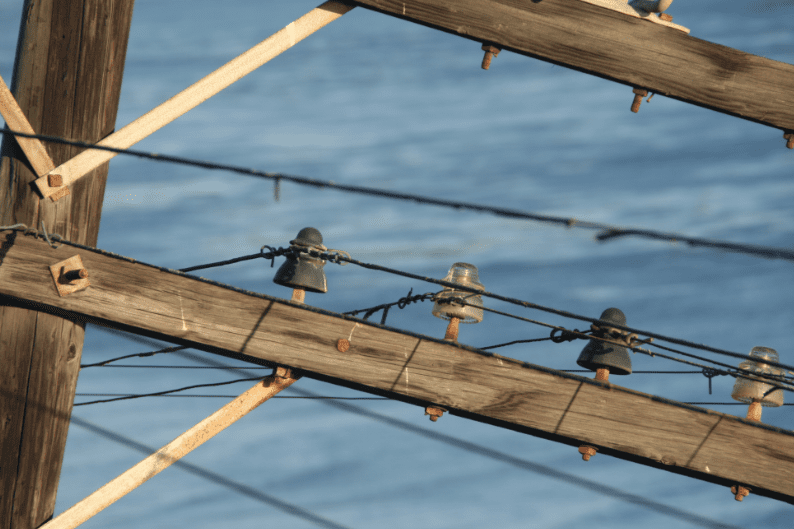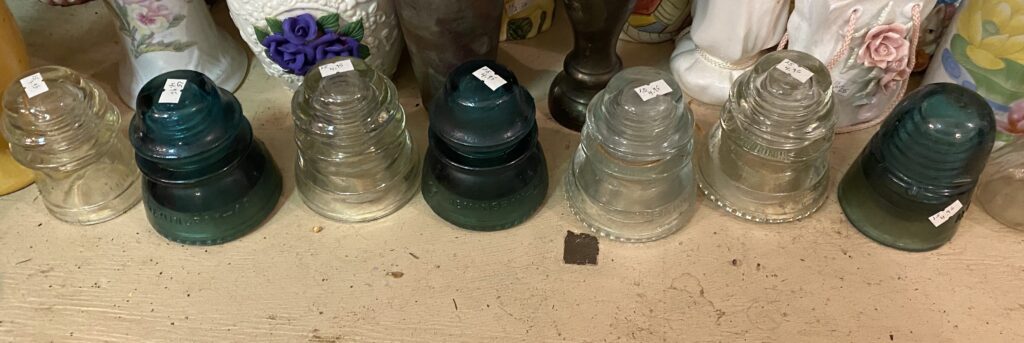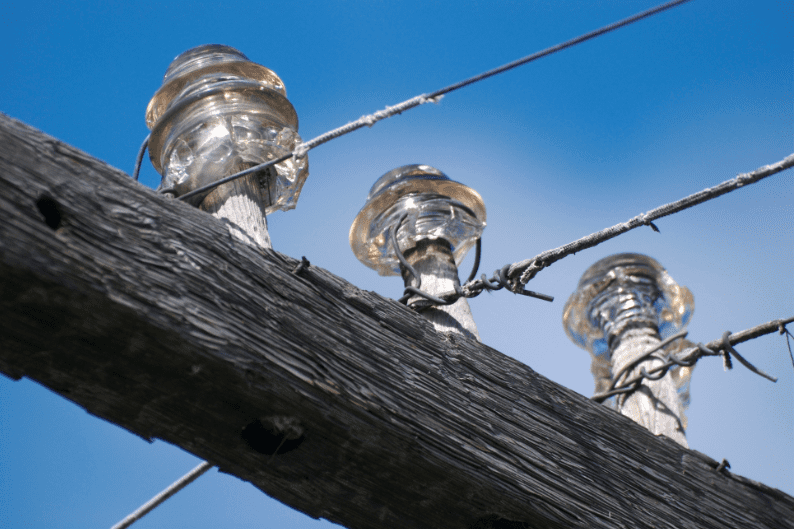Once spread far and wide across cities, towns, and the countryside, glass insulators are fascinating items that have largely disappeared from our streets & homes. But they once played an important part in early electrical development and in some places, they still refuse to be outmoded.
Glass insulators were used along electrical lines across the US from the first telegraph sent in May 1844 to the mid-20th century. Beginning with telegraph wires, glass insulators were the most reliable option for long-distance wires through the early years of electrical lines. Rubber, wood, and metal solutions didn’t stand up to being exposed to the elements as well, leaving glass insulators with an established niche until ceramics rose to prominence later on.
Read on for a closer look at the timeline of glass insulator development & a look at some outstanding insulators still in use.

What is the oldest glass insulator?
The oldest glass insulator was used on Samuel F. B. Morse’s inaugural telegraph system in May of 1844. Called a bureau knob, for its resemblance to the item in question, this type of insulator would be improved upon (or overhauled entirely) by various innovators over the course of the next twenty years.
The earliest paper record of a glass insulator comes from an 1847 patent.[1] This insulator was designed to be embedded in the wooden cross arm of a telegraph pole.[2] Markedly different from what would later become the norm for insulators, this piece is known to history by another straightforward delineation, this time “glass block”.[3] A fair description, this was basically a small glass brick—generally about 2-3 inches square—with a hole or channel through the center for the wire to run through.

A similar design was advertised by James Spratt in Cincinnati the next year, this time as a lightning rod insulator to be used on private residences. This was the first solid reference to a glass lightning rod insulator, but it’s likely they had been in use for years prior.[4] It is generally thought that lightning rod insulators are the origin point for the glass insulators that would become a familiar site in the decades to come.
Around the same year, returning to telegraph wire insulators, an iron-shelled design was patented. Solid molded glass was poured around a mounting shaft inside the iron shell. This work is commonly attributed to a Professor G. W. Benedict. These early styles shared a common issue: solid molded glass cracks easily under tension stress.[5] With electrical wires tensing and loosening subject to the weather, this proved to be an ongoing issue.
More information on the oldest glass insulators here.
Who made the first insulators?
There were several glass companies manufacturing various forms of early threadless insulators. A variety of solutions were used to insulate the wire while keeping it secured to the post. Some were rubber-based (Goodyear was a main producer of this type) and other were glass-based, often either covered or secured with wood pieces. McKee[6], Wade[7], and Tillotson[8] were a few companies involved in these early insulators.

To resolve the cracking issue, insulators had developed into a bell-shaped cast glass item secured by a central pin by the early 1860s. Despite no longer being solid blocks of glass, the same issue of tension stress came up again—this time causing these “pin-style” insulators to pop loose off their bearings.
In 1865, a patent for a threaded pin design was licensed by the Brookfield Glass Company. This type would become the industry standard for insulators for the next 85 years, quickly copied by other companies. However, Brookfield held their leading edge fairly well. It is estimated, based on the number of Brookfield insulators known today, that the company was second only to Hemingray for insulator production in the first half of the 20th century.[9]
Where were glass insulators used?
By the late 1800s, as companies fine-tuned the production of a reliable glass insulator, they were being used everywhere from private residences to cities streets to running along railway lines. These glass pieces were a common sight up until the 1960s.

As glass had more long-term durability at an economical price over the ceramics and rubbers of the day, glass insulators were used for the majority of electrical grid development and railway-side power lines set up for roughly eighty years, from the late 19th to mid-20th centuries.
Glass insulators were used to connect private residences to the larger grid as well, as shown by a pair of glass insulators found at the exterior connections on a private home in Kansas City in the early 2000s.[10]
When did they stop using glass insulators?
Ceramic became a better option for insulators through the 1950s and 60s. By the latter half of the 20th century, glass insulators were out of vogue and no longer being installed on lines. Glass is a very durable material in the right condition however, so while they were no longer actively installed … some remain on the lines still, seven decades on.
Where are glass insulators still used?
While many of the glass insulators were replaced in the later 20th century, not all of them were replaced before collecting said insulators began catching interest. One aspect of that collecting quickly became capturing pictures of glass insulators still on the lines. A list of such instances compiled from about 1997 to 2005 ranged from Walla Walla, WA to Sioux Falls, SD to Corning, NY.[11] It included glass insulators found on private homes; crossarms full of 8-12 different lines and their respective insulators; and lines of suspension insulators hanging on the wires mid-air.

Of unusual note was a line photographed in 2001, along a railway somewhere in the Southwest region. Several wires, running every few inches from top to bottom, across 10 or so poles—far more than is usual for electrical relays—had easily over a hundred insulators in this one area. This was explained as a rock fall detector: if triggered, trains would be instructed to proceed at cautious speeds in case of damaged rails.[12]
While a few on that list were noted as they were replaced, and probably more have been replaced by now, there are still glass insulators in service today. An anonymous Reddit user shared a picture of a glass insulator still installed on their private residence in 2021[13], while Hemingray insulators were found alongside an Illinois train line in autumn 2022[14]. The search continues, even as the items of interest become rarer, replaced by upgraded systems.
Antique glass insulators are consistently becoming more and more of a collector’s item and less of an active part of day-to-day life, but they are handsome reminders of an earlier era that people continue to make room for. Some of the more widely-produced insulators (Hemingray-42, looking at you) are being repurposed into wall décor, retro-style lighting, or even candle holders—so maybe, in a way, they remain in-use still after all.
Check out our article on valuing vintage glass insulators for more information.
[1] https://www.insulators.info/articles/early/
[2] https://www.insulators.info/icon/articles/cd-731.htm
[3] https://www.insulators.info/articles/early/glassblk.htm
[4] https://www.insulators.info/go-withs/lri.htm
[5] https://www.insulators.info/articles/early/benedict.htm
[6] https://www.insulators.info/articles/fruitref.htm#MCKEE
[7] https://www.insulators.info/articles/early/wade.htm
[8] https://www.insulators.info/icon/articles/cd-731.htm
[9] https://glassbottlemarks.com/brookfield-glass-company/
[10] https://www.insulators.info/service/cd162cobalts.htm
[11] https://www.insulators.info/service/
[12] https://www.insulators.info/service/154fence.htm
[13][13] https://www.reddit.com/r/Insulators/comments/s0z6m8/noticed_my_house_still_uses_a_glass_insulator/
[14] https://www.reddit.com/r/Insulators/comments/xn4soz/todays_hunt_on_the_ol_illinois_central/

